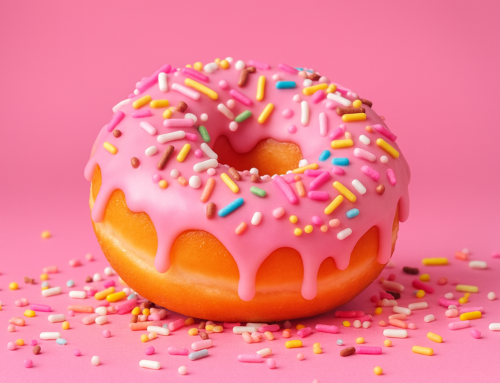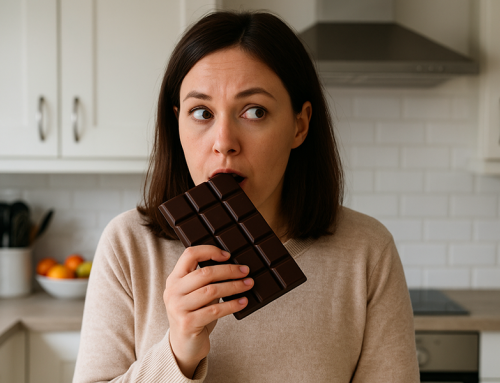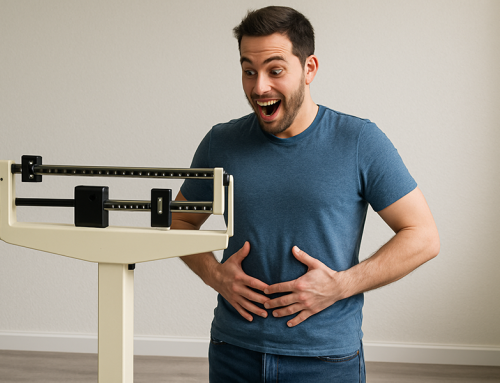Today’s Burn the Fat Blog post answers a reader question about why his fat loss stopped and explains the real reasons why people hit fat loss plateaus. It happens especially when you get down to that “last 10 lbs” or when you drop a lot of weight, and you reach good “lean” category, but you’re an overachiever and you still want to get even leaner… all the way to “ripped”, or at least lean enough to see your abs. It’s a challenge, but there is something you can do about it – more than one thing! Read on to find out.
Q: Tom, I know you often say that to get to the point to be able to see your abs, you need to get to single-digit body fat. What if I hit a plateau at about 12% body fat? What do I need to do to break the plateau and get my fat% down to single digits? Should I do more cardio, more weight-training, manipulate my diet somehow?”
A: There’s more than one way to break a plateau. You could use any of the strategies you mentioned; you could reduce your calories, increase your cardio or bump up your weight training volume. You shouldn’t limit yourself to just one way or even a few ways. My own plateau-breaking checklist has 21 strategies on it.
One of the problems I see with quite a few programs is that they’re too rigid about what you are and aren’t allowed to do. It should be the other way around – the person with the greatest number of strategies and the most flexibility is the person most likely to get through a plateau.
You should also keep in mind that the ideal plateau-breaking method may depend on how long you’ve been dieting and what kind of condition your body is in now. A dieted-down person trying to get even leaner and crack single digit body fat (to have ripped abs) is very different from someone who just started dieting and is still carrying a lot of body fat.
But before you choose any plateau-breaking strategy, the very first thing you need to do is get very clear in your head what a plateau really is. This is important, because plateaus are highly misunderstood and if you don’t know the cause of a problem, it’s nearly impossible to fix it. The cause of plateaus is actually very simple and all boils down to one thing:
If you were losing weight, but not losing weight now, there’s only one thing that that could mean; you were in a calorie deficit before, but you’ve lost your calorie deficit.
There are four primary reasons you lose your calorie deficit and hit a plateau:
The first reason you hit a plateau is because your metabolism decreases while dieting and losing weight. While this does not completely stop fat loss, it does slow down fat loss. If you’ve been cutting calories, especially if you cut them severely, your body adapts by decreasing the metabolic rate. That’s sometimes known as the “starvation response” or “adaptive thermogenesis.”
The second reason is that you need fewer calories after you lose weight. Calorie needs are directly tied into your body weight. One problem is that after people lose a lot of weight, they tend to keep eating the same way they did when they were heavier. But when you’re a smaller person, you don’t need as many calories as before, even at rest (your basal metabolic rate is lower).
The third reason is that when you move that smaller body, you’re not burning as many calories. If you strap on a weighted vest or heavy backpack and go out and hike up a hill, you can tell, obviously, that if you’re lugging around extra weight, it’s a lot more work, and you’re burning more calories.
The fourth reason is that most people don’t stick closely enough to their nutrition plan and they forget to record part of their food intake. This one requires a lot of self-honesty. Even if you don’t do it intentionally and you don’t “cheat” per se, (a lot of eating behavior is directed unconsciously), we’re not very good at estimating how much food we eat when we simply try to guess. Some studies have exposed under-reporting calorie intake as much as 50%. You say, “I’m only eating 1,200 calories a day, but I’m stuck at a fat loss plateau!” But you’re really eating 1,800 calories a day which doesn’t give you much of a deficit.
All of these reasons for plateaus get amplified in the later stages of a diet, because biologically speaking, your body is doing everything it possibly can to get you to go off your diet and to get weight to stabilize.
After a long period of dieting and after a large weight loss, your body cranks up the appetite, stimulates cravings and tries to trick you into moving less and eating more.
The leaner you get, the longer you’ve been dieting and the more aggressively you cut calories, the more your body tends to defend its weight, and hold on to remaining body fat.
So it’s really common to hit a plateau when you’re dieted down and leaner. Usually it’s nowhere near as difficult for the overweight person to start losing weight as it is for the lean person to get even leaner. The last 10 pounds is usually a lot harder than the first 10.
If you think about it, it’s pretty unnatural from a biological perspective to walk around with really low single-digit body fat. It’s not beneficial from a survival-of-the-species point of view to have low body fat. So this metabolic adaptation becomes more pronounced the leaner you get and you have to be prepared for some hard work and strict discipline to achieve it.
When you’re dieted down, you’re also at a higher risk of losing muscle, because extra muscle is not economical when there’s a calorie shortage. Carrying extra muscle is like having an engine that’s bigger than you need – it’s a gas guzzler.
The ultimate answer to why you plateau, why that last 10 pounds is so hard to lose and why it’s hard to break into those single digits is that you were in a calorie deficit before, but for all the reasons mentioned above, you’re no longer in a deficit.
The way to break the plateau then is to:
1. Re-stimulate metabolism and re-set fat-burning and starvation hormones (if necessary)
2. Re-establish the deficit.
3. Keep after it! (persistence, persistence, persistence)
Before you think about what strategies you’ll use to re-establish the calorie deficit, there’s one thing you might want to do first. If you’ve been dieting a long time, give your body a short break from all the calorie restriction. Raise your calories to maintenance level for at least one week and up as long as two weeks if you were seriously depleted.
During this diet break, you’re obviously not going to lose fat, and you might even gain a little scale weight from water and glycogen. You have to be okay with that and think of it as one step back for two steps forward.
A week or two at maintenance calories has mental and physical benefits. It gives your body a physiological break from the stress of dieting, which makes it easier to stick with your nutrition plan when you go back to it. The diet break also resets the “starvation hormones” and stimulates your metabolism.
Then, when you go back to the calorie deficit, your body starts responding again like it’s supposed to and you can make that final push to a six-pack abs level of leanness.
Another strategy you could use is carb cycling, where you take one or two higher calorie “reseed” days every week. The refeeds only last one day, but they can make dieting more tolerable, help improve muscle retention and help reduce the odds of hitting another plateau.
Because so many people underestimate how much they eat, if you hit a plateau, you should start tracking your food intake. Work off a meal plan on paper, with the calories and macronutrients subtotaled for each meal and totaled for the day. Then weigh or measure your food portions to be sure you are hitting your daily calorie and macro goals.
You may have been told many times by a lot of different experts that you don’t have to count calories to lose weight and you may even know people who lost weight simply by estimating portion sizes. That’s fine if you’re successfully losing fat, but if you’re stuck at a plateau, I consider it mandatory to stop guessing and start getting serious about doing your nutrition by the numbers.
The Best Ways To Re-establish Your Calorie Deficit
Once you’re tracking everything you’re eating, so you’re sure about your compliance to the correct calorie intake, then if you’re still stuck or you hit a plateau again later on, what you need to do is re-establish you calorie deficit. In other words, you need to eat less, burn more or a little bit of both.
You can work on the nutrition side (calories in) by reducing your food portion sizes and choosing less calorie-dense food types. Or you can use the exercise side (calories out) by increasing training volume. You have many choices on the training side.
You can increase your cardio duration (burn more calories by working out longer) or increase your cardio frequency (burn more calories by working out more often). You can also increase the intensity of your cardio so you burn more calories in the same time you’re already spending (a good strategy for busy people). That’s three different strategies for cardio alone (duration, frequency and intensity).
If your weight training has been low in volume or frequency, you can do more weight training as well. A three day a week program can be expanded to four or five, sets and exercises can be added, more metabolically-demanding exercises can be used and intensification techniques can be added.
The whole idea is simply to expend more calories (and stimulate your metabolism) or pull back your calorie intake, which re-establishes or increases your calorie deficit.
You could make one change at a time like adding an extra day of cardio, or make multiple changes all at once, like increasing both cardio frequency and intensity, plus reducing portion sizes at the same time.
Which strategies you choose depends on what makes the most sense given your current situation. And always remember that there are two sides to the energy balance equation, not one. There’s more than one way to break a fat loss plateau.
Want to Learn More?

If you’re a current member, simply log in to the Burn the Fat Inner Circle members area with your current username and password, and click on “audio coaching” to download the program.
Until next time,
Train hard and expect success,
Tom Venuto
Fat loss coach
PS. If you’re not a member of Burn the Fat inner circle yet, you can get the 21 Ways to Break a Fat Loss Plateau program by joining our community (audio coaching “essentials series” is included with membership), or you can purchase the program separately in the Inner Circle Store here: www.burnthefatinnercircle.com/products/item44.cfm

Tom Venuto is a lifetime natural (steroid-free) bodybuilder, fitness writer and author of Burn The Fat, Feed The Muscle: Fat Burning Secrets of Bodybuilders and Fitness Models and the national bestseller, The Body Fat Solution, which was an Oprah Magazine and Men’s Fitness Magazine pick. Tom has appeared in The New York Times, Wall Street Journal, Huffington Post, Oprah Magazine, Muscle and Fitness Magazine, Ironman Magazine and Men’s Fitness Magazine, as well as on dozens of radio shows including Sirius Satellite Radio, ESPN-1250 and WCBS. Tom is also the founder and CEO of Burn The Fat Inner Circle – a fitness support community for inspiration and transformation






I am SO glad you shared this today. I have hit a plateau and have been stuck there now for about 2 months…it is frustrating as all get out but I keep working toward getting through it. I see my body continue to change but the number on the scale has remained the same. I am thankful it has at least remained the same……but I am so anxious to hit the next cycle of weight loss. I have already lost about 70 pounds…which actually came off pretty easily and pretty quickly looking back on it.I have not really changed my eating since then…..and realize I need to modify that again to account for my smaller size. I have also been increasing my cardio and resistance training. I still have at least another 80-90 pounds to lose. Sometimes those numbers can be daunting….but I am determined to make this happen and have the best, leanest body I have ever had in my entire life.This newsletter just confirms to me what I already figured out that I needed to do…..and it as a nice boost for my morale. So thanks again very much!
Dear Tom,I had to write to say that I love your blogs, the e-zine and the “Big Fat Lies”. They are totally awesome. I am an overachiever and am pretty hard on myself when it comes to healthy living. I want to do a figure competiton in the near future and I think that I need to go further when it comes to body fat. I am 129lbs and 21% body fat. I am struggling on reducing my body fat. Any suggestions???? By the way, I am eating clean, however, I eat quite a bit of fruit….
Eka, for figure competition, you simply have to take it to the next level; stricter, competition-level diet, harder, competition level training… big goals require big efforts.Check out the information about “super lean” next week – I’ll be making the entire seminar available on audio and ebooks. It specifically discusses how to get lean enough for figure competition, bodybuilding, six pack abs, etc.Its quite a bit different getting competition ready than it is to lose the weight inthe beginning for someone who is overweight to start.best regardstom venuto
Thank you for this newsletter. I believe that this is the information I have been waiting for. I have been in a plateau for so long now (1 and 1/2 years) that I was almost ready to give up. I have been eating right for so long and I have been so mad at my dang body for not just “getting ripped on its own like it’s supposed to.” I didn’t realize that “the last 10 lbs” are the most difficult of all. I am no longer in a calorie deficit (those were the words I needed to hear). I didn’t realize that that was the case. Now that I think about it, it’s 100% true. Energy In – Energy Out = Energy Accumulation (fat storage). Perhaps I truly have been eating exactly what I’ve expended because I look exactly the same as I did a year-and-a-half ago. Tell you what: I’m going to do this right. I’m going to track my calories and make adjustments as needed. I’m going to increase my intensity. This time…I’m going to get it right — finally.Sincerely,Quinn Kotter
Comments: I would like to suggest another reason a person may hit a plateau is that he may be having two conflicting objectives so he could not make the progress. My body fat flew downward at age 54 from over 30% to about 17% in four months while keeping my weight of 177-180, then I got the marathoning bug, then it crept down to about 14%. I consulted a personal trainer who advised me that I am trying to hang to too much muscular bulk while my body is adapting to my marathon training where I really ought to let more weight to come off in order to acheive less body fat. My suggestion is if you have a plateau, you may want to consult a good trainer who could help pinpoint conflicting objectives or help you be honest on the amount in the diet or workouts. If you have conflicting objectives you may simply have to make a choice. I also like your suggestion that since I am smaller I probably need less, that was probably true in my case as well. Keep up the good work!
Thomas wrote:I would like to suggest another reason a person may hit a plateau is that he may be having two conflicting objectives so he could not make the progress.Yes, without a doubt. I have written about this subject on many occasions, and i often call it “flip flop syndrome” where some one cant make up their mind whether the primary focus of their program should be fat loss or muscle gain so they flip flop between the two, in effect, cancelling each other out.As the old saying goes, “he who chases two rabbits catches neither.”It all points back to the same ultimate cause, however: no calorie deficit.Thanks for your comments!Tom Venuto
Dear Tom-this post was like reading my mind!I am 38 (almost 39) and I have 3 kids with my oldest being 12 and my youngest 2. I am 5 foot 2 and have always been about a size 3-4 but after my 3rd child I went up to a size 7-8 and I was just so uncomfortable in my own skin at that size.Some how I stumbled on to your Burn the Fat, Feed the Muscle website, and I thank GOD that I did!! Since reading and buying your book I am now in a size 1-2. I don’t even know how much I weigh because I stopped using a scale to determine my success and now I use a pair of jeans and my mirror!!Your book has changed my life and I will be forever thankful that I found your wonderful and truthful teachings!!However this is my only last fight- my “under the belly button pouch” My last baby was almost 10 lbs and I had to have a c- section and now I can’t get rid of this annoying but small bulge below my belly button.I feel like I am working out 5-6 days a week so I should see it go away but now I am thinking could this be extra skin-I just know but I will continue on with your program as my new way of life. I can’t eat my old stuff if I wanted too- it literally makes me sick.I thank you Tom from the bottom of my heart for changing my life and educating me the right way !!!!Sincerely,Bonnie
Dear Tom First off I want to thank you so much for your insight into the world of losing weight. I’ve tried off and on and yes a victim of the yo yo dieting. I’d lose weight only to put it on plus more once I tried to maintain and always lost the battle. I realize now that it’s a lifestyle of changes.My concern now is that I am 52 and in the last year I have lost 70 lbs. I feel terrific but like your article I have been at a plateau for over 2 months. I am 5 foot 2 and weigh 136 which is still about 10 lbs off of what I would love to be. However I have alot of loose skin and am embarassed about it. Is there anything I can do to help get my skin to meet back up with my frame? I’m worried actually about losing more weight as I can see that this excess skin will only appear worse. I’ve been so depressed about this that I am fighting myself with feelings of putting weight back on! Any advice? Thank you in advance
Dear Tom,Thanks for ur wonderful post.This has guided me to achieve my goal in a better way.thanks a ton.
Tom says;””flip flop syndrome” where some one cant make up their mind whether the primary focus of their program should be fat loss or muscle gain so they flip flop between the two, in effect, cancelling each other out.”Exactly! I think a lot of people think you can burn muscle and lose fat at the same time. To burn muscle you need a calorie surplus to lose fat a calorie deficit – they are contradictory!!
I would like to point out that some drugs such as anti depressants, biporal medications as well as anti psycotic medications can and do contribute to obesity in those unfortunate to have to take them
Denisthanks for your post. Yes, in fact, there was an article on anti depressants and anti psychotics and weight gain in a recent issue of the journal “Obesity Management” that included all the scientific references that confirmed this.So, I suppose you could add this to a list of reasons for a plateau, although Id put it more in the list of “miscellaneous” other reasons that weight loss might be slow to begin with, not why one might lose weight just fine for a while and then stop for no apparent reason. (unless you start taking those drugs while in the middle of a weight loss program and your progress stops… in which case Id think youd put 1 + 1 together)The good news is, this doesnt mean those who use such drugs cant lose weight; it’s simply all the more reason they have to ramp up their exercise and not depend on diet alone, because if someone has a decrease in thermogenesis due to a prescription drug, its very difficult to lose fat using food reduction alone. You can only create so much of a calorie deficit on the food reduction side of things.if someone is prescribed anti depressants their doctor or pharmacist should warn them about the potential side effect of weight gain and advise them to increase their exercise above their current level.best regardstom
I often hear my friends say ‘Counting calories ? Forget that !’, but I tell them, it is a temporary learning curve. Most people are a creature of habit when it comes to the foods they eat, whether healthy or indulging, I think we all tend to eat what we enjoy.Counting the calories in the interim is a temporary measure, because it then becomes second nature in judging portion sizes and knowing the calorie content in that food. My point is, if anyone is concerned about having to count the calories, it’s only a matter of learning the numbers. Then, when you make your egg white omelettes and oatmeal, you’ll already know what the numbers are !
JR, could not agree with you more. you dont need to count calories forever, only be aware of the caloriebalance equation forver and respect portions forever. The actual, literal calorie counting is temporary while you pass from unconscious incompetence through conscious competence, finally into unconscious competence.
I will never understand the human bodies propensity to stop weight/fat loss. Every winter I gain weight back..so one winter I was in Top Shape, and vowed that this was not going to be the winter that I let it happen.
So I tracked intake, ramped up Cardio both duration and intensity, doing bricking workouts with a bad ass trainer that burned 1400 -1700 Kcals….
At the end of a month after killing myself…I GAINED 4 LBS of FAT though I was clearly in a deficit as I was burning 500+ kcals/Day and kept a small deficit of cals from food of ~ 3-400 Kcals….
Based on an energy balance…what the numbers suggested is my new caloric needs were now ~800 Kcals/day…afterall….I was clearly in 14,000 calorie surplus over that month where my tracking suggested I should have been 14,000 Kcals under to loose a pound a week. For a 198 lb male with double didgit body fat that isn’t all that severe and expection.
I was quite defeated after that….How could I exist on 800 kcals?…so once again I hit the first day of spring at 208 lbs, even though I did 4X a week of Spin with 2 rounds of tabata each….4 days of weight training, 2 Power Yoga classes and 2 Rounds of Will, Power and Grace/Barefoot Fitness.
Eventually the outdoor cycling season helped get me back….but the human body is a black box…and it will do whatever it can to stop fat loss.
At one point I stopped sweating altogether….my wife accused me of going out breakfast instead of going to the YMCA….lol.
Likely This was a result of leptin downregulation, I had my Thyroid checked but it was normal despite my body temperatutre in the AM running at 96.8…..instead of 98.6…..Adaptive Thermogenisis!